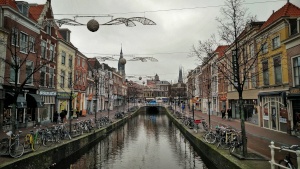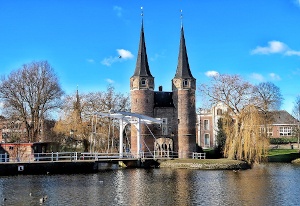Peg writes:
On the Hoogvart, between Hoogeveen and Nieuw Amsterdam, we are in the deep countryside of eastern Netherlands, passing through a very prosperous-looking area with many large farms. In the first photo, you will see a very large roof. This is because the barn is attached to the house, as is the custom in rural areas. In the second picture, a good example of how well the farmers seem to be doing here, you’ll see on the left a large Palladian-style double door. It is the carriage/wagon entrance to the barn.
There are 20 bridges on this canal, most of them about two feet above the water level. We have our very own bridge master, who opens each bridge as we arrive, closes it after us, then speeds past us along the road in his car to the next bridge. Makes one feel important!
A brugemesiter (bridge tender) stays with you as you proceed through the sequence of bridges assigned to them. The boaters try to go through together, meeting on the docks to make arrangements. They try to limit the amount of time the bridges stay open, as vehicles use the bridges. On major canals, several bridges are managed from a central location with cameras at each bridge, so the brugmeister sees when he needs to open a bridge. There is a phone number or VHF radio frequency the skipper can use to request an opening. At every bridge there is a red/green light. Red means nobody knows you are there or that a barge is coming from the other side and will smash you to smitherines if you are in the way) red WITH green (like in this photo) means the bridge is getting ready for you (so you know somebody somewhere has seen you), and green means OK to go NOW. Out of courtesy boaters try to move through as quickly as they safely can.











